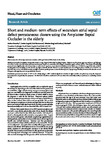Short and medium-term effects of secundum atrial septal defect percutaneous closure using the Amplatzer Septal Occluder in the elderly
| dc.contributor.author | Broadley, A | |
| dc.contributor.author | Gogola, L | |
| dc.contributor.author | Roobottom, C | |
| dc.contributor.author | Ring, N | |
| dc.contributor.author | J Marshall, A | |
| dc.date.accessioned | 2022-03-08T14:15:52Z | |
| dc.date.available | 2022-03-08T14:15:52Z | |
| dc.date.issued | 2017-10-28 | |
| dc.identifier.issn | 2515-091X | |
| dc.identifier.issn | 2515-091X | |
| dc.identifier.uri | http://hdl.handle.net/10026.1/18922 | |
| dc.description.abstract |
Aim: to assess the effects of percutaneous secundum atrial septal defect (ASD) closure in the elderly. Methods and results: Descriptive, retrospective study in a large Regional University Teaching Hospital. Subjects were 11 patients aged over 60 (mean age 72 [range 62 to 83], 3 male) at the time they underwent percutaneous closure of a secundum ASD using an Amplatzer septal occluder (ASO). Post-closure the following parameters were significantly reduced: heart size on serial chest X-ray, from a mean (standard deviation) of 16.7 (2.1) cm to 14.8 (1.3) cm (p=0.016) after 4.5 (2.1) months; pulmonary vascularity on serial chest X-ray; right ventricular diastolic diameter on serial transthoracic echocardiogram, from 4.2 (0.8) cm to 3.0 (0.74) cm (p<0.001) after a mean of 15 (12.2) months; and right ventricular systolic pressure measured indirectly (n=4). Symptoms, particularly shortness of breath, also seemed to improve although they were not quantitatively assessed. Conclusion: percutaneous closure of ASD in the elderly using an ASO results in significant reduction in right ventricle and pulmonary artery size, improved haemodynamics and probably also symptoms. On this basis it should be considered in all cases where it is technically feasible, in preference to continuing medical therapy. | |
| dc.language.iso | en | |
| dc.publisher | Open Access Text Pvt, Ltd. | |
| dc.title | Short and medium-term effects of secundum atrial septal defect percutaneous closure using the Amplatzer Septal Occluder in the elderly | |
| dc.type | journal-article | |
| plymouth.issue | 3 | |
| plymouth.volume | 1 | |
| plymouth.publication-status | Published online | |
| plymouth.journal | Blood, Heart and Circulation | |
| dc.identifier.doi | 10.15761/bhc.1000117 | |
| plymouth.organisational-group | /Plymouth | |
| plymouth.organisational-group | /Plymouth/Faculty of Health | |
| plymouth.organisational-group | /Plymouth/Faculty of Health/Peninsula Medical School | |
| plymouth.organisational-group | /Plymouth/REF 2021 Researchers by UoA | |
| plymouth.organisational-group | /Plymouth/REF 2021 Researchers by UoA/UoA01 Clinical Medicine | |
| plymouth.organisational-group | /Plymouth/REF 2021 Researchers by UoA/UoA01 Clinical Medicine/UoA01 Clinical Medicine | |
| plymouth.organisational-group | /Plymouth/Users by role | |
| plymouth.organisational-group | /Plymouth/Users by role/Academics | |
| dcterms.dateAccepted | 2017-10-25 | |
| dc.rights.embargodate | 2022-3-9 | |
| dc.identifier.eissn | 2515-091X | |
| dc.rights.embargoperiod | Not known | |
| rioxxterms.versionofrecord | 10.15761/bhc.1000117 | |
| rioxxterms.licenseref.uri | http://www.rioxx.net/licenses/all-rights-reserved | |
| rioxxterms.licenseref.startdate | 2017-10-28 | |
| rioxxterms.type | Journal Article/Review |


